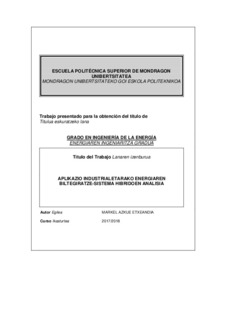| dc.contributor.advisor | Martínez Laserna, Egoitz | |
| dc.contributor.advisor | Iraola Iriondo, Unai | |
| dc.contributor.author | Azkue, Markel | |
| dc.date.accessioned | 2021-02-02T10:06:05Z | |
| dc.date.available | 2021-02-02T10:06:05Z | |
| dc.date.issued | 2018 | |
| dc.identifier.other | https://katalogoa.mondragon.edu/janium-bin/janium_login_opac.pl?find&ficha_no=151696 | en |
| dc.identifier.uri | https://hdl.handle.net/20.500.11984/5196 | |
| dc.description.abstract | Gaur egun, elektromugikortasunaren eta energia berriztagarrien hazkundea dela eta, energia- eta potentzia-eskakizun handiko aplikazio berriak agertu dira. Orain arteko biltegiratze-sistema gehienek zailtasunak dituzte aldi berean energia- eta potentzia-eskaerak asebetetzeko, eta, ondorioz, bi ezaugarrietako batean gaindimentsionatu egiten dira maiz. Lan honetan, Li-ioi bateriaren eta EDLCaren arteko HESS erdi-aktiboaren diseinua eta garapena azaltzen da, bai eta bi sistemak konbinatzeak ekar ditzakeen onurak aztertu eta simulatu ere. Sistema bateriak energia era ia konstantean emateko pentsatuta dago; EDLC multzoa, bestalde, kargaren zati dinamikoaz arduratzen da. Horren bitartez, posible da energia-gaitasun handia duen bateria erabiltzea, puntako potentzia altuak eskatzen dituen karga izan arren. Gainera, KZ-KZ bihurgailua dela eta, posible da EDLC multzoak eta bateriak tentsio ezberdinetan egotea. Dokumentu honetan, HESS erdi-aktibo baten ezarpena eta baliozkotzea azaltzen dira, horrelako sistema batek eskaintzen dituen abantaila nagusietan sakonduta. Sistemaren gainean kontrola izateko, Arduino bat erabili da zenbait neurgailu baliatuz. Sistemari ezarritako diodo bati esker, gainera, sistemak era pasiboan funtzionatzeko aukera ematen da. Proposaturiko sistema autobus elektriko batean erabiltzeko aukera dagoela egiaztatzeko, simulazioa eta emaitza esperimentalak aplikazio finalera begira aztertu dira. | eu |
| dc.description.abstract | Nowadays, due to the incrementation in the use of the electromobility and renewable energies, applications with high energy and power demand have appeared. The energy storage systems used have difficulties to fulfill the energy and power demand, and, as a result, they are often overdimensioned in one of those factors. In this work, the design and development of a semi-active HESS composed by a Li-ion battery and a HESS bank are explained. Also, the benefits of combining both systems are examined and a simulation has been carried out. The system is designed so that the battery supplies energy in an almost continuous way; on the other hand, the EDLC bank will manage the dynamic part of the load. That way, it is possible to use a high energy capacity battery, even though the load demands high power peaks. Also, as a result of the use of the DC-DC converter, it is possible to use a different voltage in the EDLC bank and the battery. In this document the implementation and the validation of a semi-active HESS are explained, and the main advantages that the system offers are examined in depth. In order to have control over the system, an Arduino is employed using some measuring devices. Owing to a diode placed, also, the system can be used in a passive way. To be sure that the system can be used in an electric bus, a simulation and experimental results are analyzed with regard to the final results. | en |
| dc.description.abstract | El incremento que se ha dado últimamente en el uso de la electromovilidad y las energías renovables ha provocado la aparición de nuevas aplicaciones con gran demanda de potencia y de energía. Los sistemas de almacenamiento que se utilizan hoy en día tienen complicaciones para poder cumplir con dicha demanda; es por ello que se suelen sobredimensionar en alguno de dichos factores. En el presente trabajo se explica el diseño y desarrollo de un HESS semi-activo formado por un banco de EDLC y una batería. Se ha simulado el sistema y se presentan también las ventajas que tiene combinar estos dos sistemas. El sistema está pensado para que la batería proporcione energía de forma casi constante; por otro lado, el banco de EDLC se ocupa de la parte dinámica que presenta la carga. Así, es posible utilizar baterías con una gran capacidad energética, aunque la carga demande grandes picos de potencia. Además, gracias al convertidor CC-CC, es posible que el banco de EDLC y la batería funcionen a tensiones diferentes. En este documento se explica la implantación y la validación de un HESS semi-activo, profundizando en las ventajas principales que ofrece este tipo de sistema. El control del sistema se lleva a cabo por medio de un Arduino al que se han añadido unos elementos de medición. Gracias al diodo que se ha utilizado, se da la posibilidad de que el sistema funcione en forma pasiva. Para verificar que el sistema puede ser implementado en un autobús eléctrico, se han analizado una simulación y los resultados experimentales de cara a la aplicación final. | es |
| dc.format.extent | 88 | en |
| dc.language.iso | eus | en |
| dc.publisher | Mondragon Unibertsitatea. Goi Eskola Politeknikoa. | en |
| dc.rights | © Markel Azkue Etxeandia | en |
| dc.subject | Grado en Ingeniería de la Energía | es |
| dc.subject | 2017-2018 | |
| dc.subject | MU-Mondragon Saria (Ikasketa Amaierako Lanak euskaraz) | |
| dc.title | Aplikazio industrialetarako energiaren biltegiratze-sistema hibridoen analisia | es |
| dcterms.accessRights | http://purl.org/coar/access_right/c_abf2 | en |
| dcterms.type | http://purl.org/coar/resource_type/c_7a1f | en |
| local.identifier.doi | https://doi.org/10.48764/8ECS-AN28 | |
| local.contributor.otherinstitution | https://ror.org/03hp1m080 | es |
| oaire.format.mimetype | application/pdf | |
| oaire.file | $DSPACE\assetstore | |
| oaire.resourceType | http://purl.org/coar/resource_type/c_1843 | en |







